1888 Cherub with
Chariot Egg/
Angel with Egg in Chariot
Gift Alexander
III to Maria Feodorovna
Made in Saint Petersburg
Lost
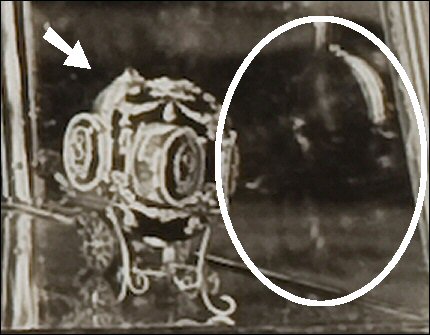
Above and Below, the Chrerub with Chariot Egg photographed in 1902 in the Von Dervis Exhibition
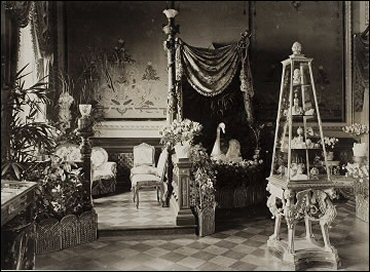
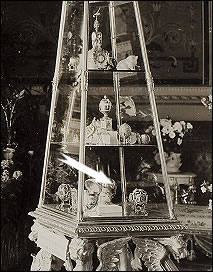
The drawings below of the Cherub with Chariot Egg, were made by Anna & Vincent Palmade to illustrate their november 2007 Fabergé Research Newsletter article about the discovery of this egg in an archival photograph of the von Dervis exposition in Saint Petersburg in 1902. With their permission, the drawing was published on this website. The drawing is designed based on the vaguely visible contours of this egg on the photograph of which below a detail.
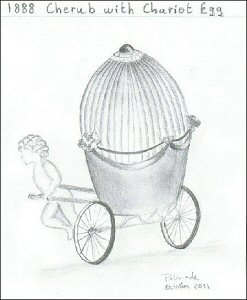
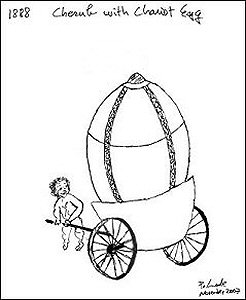
Drawings above ©Anna & Vincent Palmade October 2011, and right 2007
The tip of the egg is just left of the tip of the Caucasus egg. One wheel of the chariot appears just left of the Caucasus egg stand and the outline of the cherub pulling the chariot can be seen just above and on the left of the wheel. The overall outline of the egg can be seen on the reflection in the vitrine to the right of the egg. Read all about the research of the Palmades in their article on the Fabergé Research Site and see their drawings lower on this page.
Update April 2014
With the 2014 rediscovery of the 1887 Third Imperial Egg, hope of finding more missing Eggs flared up and the search intensified! Greg Daubney came up with a slightly different drawing, based on the image reflected in the Von Dervis showcase, see below,
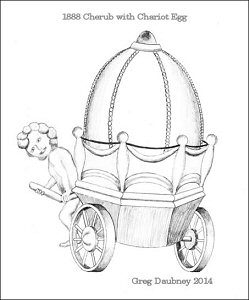
1888 Cherub with Chariot Egg - Drawing by Greg Daubney
and Kieran McCarthy of Wartski provided the image below of a pair of mustard pots in the form of small boys pushing wheelbarrows containing barrels, executed for Madame de Pompadour in 1760, possibly after a model by Falconet. This might have been the inspiration for the Egg, according to McCarthy, as the Falconet reference is encouraging and will allow us to model the cherub.
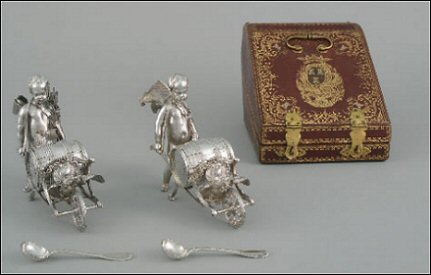
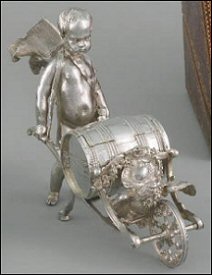
Pair of Mustard Pots and detail right.
Courtesy Museu Calouste Gulbenkian
Finally Will Lowes, author of the Lowes & McCanlessFabergé Eggs: A Retrospective Encyclopedia, 2001, provided the following information:
Parke Bernet Galleries New York - French & English Furniture, the Ethel G. Douglas Collection of Wedgwood Ware, Imperial Russian art Objects, Lalique and Favrile Glass, Laces, Silver, Paintings, Rugs, Property of Mrs. Ethel Gunton Douglas, Removed from 834 Fifth Avenue, New York, Frederick Housman, Together with French Modernistic Furniture by Jansen, Paris, Collected by Henry C. Lytton, Removed from 2 Easter 88 Street, New York, With a Few Additions From Other Owners.
Friday-Saturday, September 26-27, 1941
Lot 258 - Offered by Mrs. Ethel Gunton Douglas, two Fabergé Imperial silver Easter bibelots, the first a tiny amour pushing a wheelbarrow laden with an egg, 2 in. long, and a hare drawing a hinged egg on wheels, parcel-gilded. The catalogue says both items were understood to have belonged to the children of Tsar Nicholas II. Final bid $22.50 [sic]. Note – no illustration.
It seems likely Mrs Gunston, a rich New Yorker, bought the item from Armand Hammer's 'Hammer Collection of Russian Imperial Art Treasures from the Winter Palace, Tsarskoye [sic] Selo and Other Royal Palaces' exhibition at Lord and Taylor's department store in New York, held from November 3-December 1, 1934.
The item was listed as Lot 4524 in the Hammer catalogue and was described thus: "Miniature silver amour [cupid] holding wheelbarrow and Easter Egg, made by Faberge, court jeweler. From children's half of the Alexander palace. Inventory no. 935."
Background information
Possibly sold in the 1930's to Armand Hammer. Whereabouts unknown, possibly United States.
Update December 2019. Several Fabergé enthousiasts have tried to (re-)create a good image of this missing Egg, based on the reflection in the Von Dervis vitrine (see above). Here is the latest one using a new Photoshop technique, made by Greg Daubney.


Both images above, ©Greg Daubney
![]() 1902 Von Dervis Fabergé Exhibition in Saint Petersburg, Russia
1902 Von Dervis Fabergé Exhibition in Saint Petersburg, Russia
page updated: December 14, 2019
